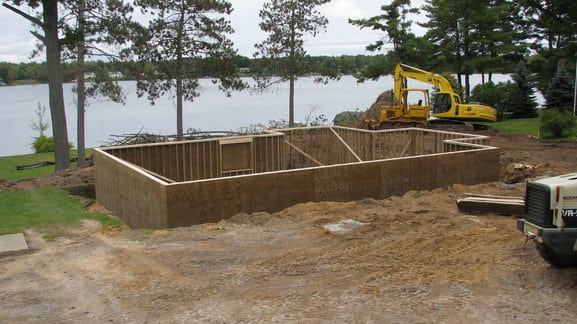August 14, 2020 | Buying
Wood Basements vs Concrete Basements

Chances are if you are reading this, you are interested in or own a property that has a wood basement. Wood basements, also commonly referred to as a PWF standing for Preserved Wood Foundation or Permanent Wood Foundation, are a common building practice. A wood basement can have many advantages to a conventional concrete basement. In this post, we will compare wood foundations vs concrete foundations.
Wood Foundations vs. Concrete Foundations
What is the purpose of a basement?
Before we start talking about a wood foundation compared to concrete, let’s discuss the purpose of a basement. Ultimately the need for having a residential basement is dictated by the climate of where the home is built. The primary function for a basement to provide a solid foundation for the structure of the house that is being built. In climates susceptible to frost, the foundation wall will sit on a footing, (generally concrete) below the frost line. When moisture freezes, it expands. When it thaws, it compresses. This is referred to as frost heave. If this footing, or foundation is built above the frost line then the structure will be constantly moving as seasons change and we don’t want that. Hence the introduction of a basement.
A secondary function of the basement is to allow for a convenient way to bring utilities into the home while protecting them from the elements. With the water line generally coming into the basement below the frost line and the sewer discharge also exiting below frost, this should keep the in’s & out’s running smoothly.
Outside of the mechanical and structural functions of a basement, come the benefits of having additional storage and living space. Some of the greatest living spaces can be created below grade.
What are the different types of foundations?
When it comes to construction techniques, there are lots of options beyond just concrete and wood. For example, we are now seeing options like Insulated Concrete Form (ICF), Precast panels, Steel Stud, or more traditional methods like concrete block, concrete, wood, many misconceptions about basement types. Many people consider concrete the best option for a basement, but I would argue that a PWF can be just as good, if not better in some applications.
Every basement needs to be protected. Plain and simple, you could have the fanciest most expensive basement built, but if it isn’t property protected with a waterproofing membrane, appropriate drainage around footing, and grading away from the foundation wall then problems will surely arise. Assuming you have these elements in place, then the wood basement has many advantages over concrete.
Quicker to build:
With a poured concrete wall there are many additional steps. After your footing is poured, contractors will form the walls, place the re-bar, pour the concrete, strip the forms, and then you have to wait for the concrete to cure properly so it is strong enough before you can start backfilling and building.
Easier to modify:
How many times have you wished for that additional window in the basement? Not an easy (or cheap!) task with concrete, and requires specialized equipment and manpower to cut doorways or windows in place. If reengineering is required to ensure your modifications are structurally sound it is much more challenging with concrete. With wood the materials are readily available and it is generally some simple framing modifications.
Warmer:
Usually a concrete wall with only have a 2×4 interior frost wall to allow for insulation, where a PWF wall is generally 2×8 or 2×6 exterior stud which can accommodate that much more insulation.
More interior space:
Instead of having to build a second wall inside the foundation wall to run electrical, plumbing, and fasten drywall, you can complete this directly on the foundation wall giving the same footprint another 8” or more of space wall to wall.
Drier:
Unlike concrete, treated wood doesn’t absorb moisture, rather it wicks away. Concrete contains moisture in it’s makeup and easily absorbs moisture from it’s surroundings. In heavy rains and harsh conditions, wood is quicker to dry than concrete.

I have seen many homes over 100 years old with wooden basements and concrete basements. Concrete tends to flake and break away easily which is difficult and costly to repair. With wood, it is much easier to repair & reinforce.
To Summarize:
Don’t automatically assume that a property with wood basement is an inferior structure than that of a concrete foundation. When built and cared for properly, these structures can rival one built on a concrete foundation. There are many excellent construction practices and when it comes time to write the offer, make sure you hire the right inspector. Another good option is to consult a structural engineer to get their professional opinion on the foundation of the home you are looking to buy.
For additional info, here is a PDF from the Canadian Wood Council. The information is an excellent read if you own, or are considering owning a PWF. (or if you are another Realtor® looking to pass along some resources to your clients)
Stay warm and dry!
Sources for photos:
3 Comments
Comments are closed.



It’s interesting that any basement should be protected with a waterproofing structure. My wife and I are building our dream home and I am not sure what kind of foundation we should have. We’ll be sure to consult with the contractor to see what is best around our area.
As an Architect in B.C., I designed a number of homes with preserved wood foundations in the 1980’s. All of these homes are still in use and there have not been any problems with any of them, to this date.